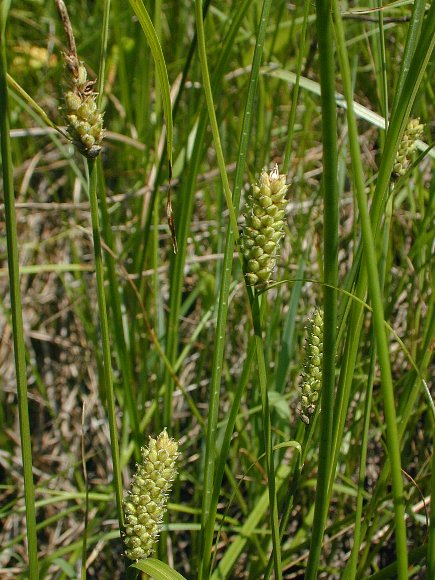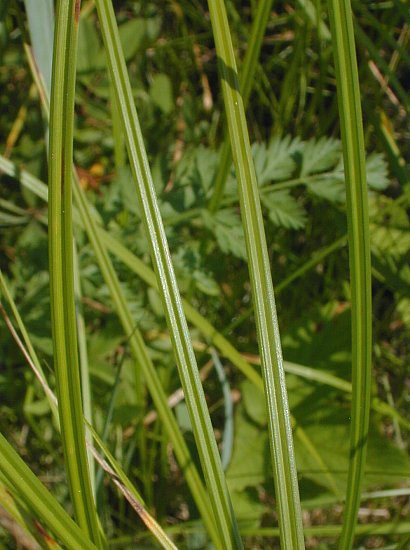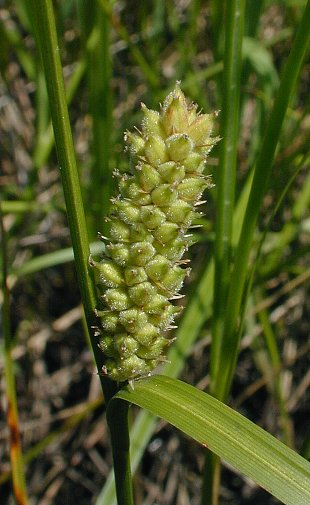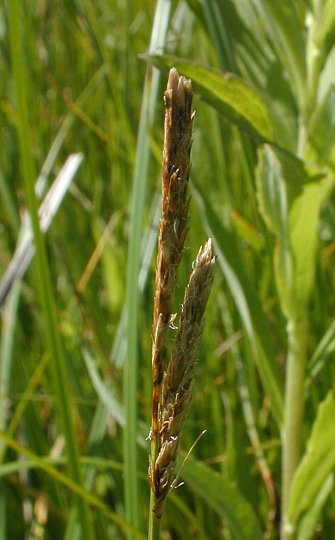Description: This perennial sedge is about 1–2½' tall and unbranched. The culm is light green, triangular in cross-section, and glabrous. There are 2-3 alternate leaves along the lower half of each fertile shoot during the blooming period; infertile shoots are also produced. The leaf blades are up to 5 mm. across and 10" long, light to medium green, and glabrous. The larger blades are furrowed along their midveins, otherwise the blades are flat. The outer leaf sheaths are light green and hairless, while the inner leaf sheaths are more membranous and translucent; the apices of the inner sheaths are concave. Each culm terminates in an inflorescence about 4-12" long. The rachis (central stalk) of this inflorescence is light green, triangular in cross-section, erect, and rough-textured along its angles. Toward the apex of the rachis, there are 1-3 staminate spikelets, while toward its middle and bottom there are 2-3 pistillate spikelets. At the base of each pistillate spikelet, there is a leafy bract that resembles the blades of the leaves, except the upper bracts are smaller in size. The staminate spikelets are about ½–1¼" long, narrow, and flattened; they become brown shortly after their pollen is shed. The staminate spikelets are only a little above or below each other; they are usually exerted ¾–3½" above the uppermost pistillate spikelet, although sometimes they are only slightly above it.

The pistillate spikelets are ¾–1¼" long and about ¼" across; they are light green to yellowish green and cylindrical in shape. Individual pistillate spikelets are densely packed with widely spreading to ascending perigynia and their scales; this provides them with a short-bristly and grainy appearance. The pistillate spikelets are usually widely separated from each other in the inflorescence; either they are more or less erect on short stiff pedicels, or they are sessile. The perigynia are 2.5–4.0 mm. long and 1.5–2.0 mm. across; they are ovoid to broadly ovoid, slightly 3-angled, and densely pubescent throughout. The apices of the perigynia have short beaks, while their bottoms taper to blunt points. The pistillate scales are lanceolate to ovate and about the same length as the perigynia; they are green-veined or purplish green-veined in the middle, while their margins are membranous. The blooming period occurs during the late spring to early summer, lasting about 1-2 weeks. The florets are cross-pollinated by the wind. The achenes ripen during the summer; they are 1.5-2.0 mm. long, broadly ellipsoid, and bluntly 3-angled. The root system is fibrous and long-rhizomatous. Clonal colonies are often produced from the rhizomes. Usually, individual plants are solitary, rather than tufted at the base with multiple shoots.

Cultivation:
Woolly
Sedge prefers full to partial sun and wet to moist conditions. This
sedge is
fairly adaptable and it is able to tolerate different kinds of soil,
including those containing loam, silt, and gravel.
Range & Habitat:
The native Woolly Sedge is occasional to locally common in central and
northern
Illinois; it is less common in the southern part of the state (see Distribution
Map). Habitats include wet to moist prairies and dolomite
prairies, prairie swales, sedge meadows, acidic seeps and calcareous
seeps, swamps, openings in floodplain woodlands, edges of poorly
drained fields, and
roadside ditches. Usually, Woolly Sedge is found in sunny wetlands,
where it tolerates degradation of habitat to some extent. Occasionally,
it will spread into the drier ground of adjacent prairies and meadows.

Faunal Associations: Caterpillars of the butterfly Satyrodes eurydice (Eyed Brown), several skippers, and moths feed on wetland sedges (Carex spp.); see the Lepidoptera Table for a listing of these species. Grasshoppers that feed on wetland sedges include Stethophyma lineata (Striped Sedge Grasshopper), Stethophyma celata (Otte's Sedge Grasshopper), and Stethophyma gracile (Graceful Sedge Grasshopper). Other insect feeders include semi-aquatic leaf beetles (especially Plateumaris spp.), Sphenophorus costicollis (Sedge Billbug), aphids, leafhoppers (especially Cosmotettix spp.), Paraphilaenus parallelus (Lined Spittlebug), and larvae of the shore fly Hydrellia griseola (Lesser Rice Leafminer). Waterfowl, rails, and other wetland birds eat the seeds and/or seedheads of wetland sedges (see Bird Table). The Canada Goose also eats the leaves. The foliage of sedges is edible to hoofed mammalian herbivores, but it is not a preferred food source. Muskrats occasionally eat the rootstocks, culms, and young shoots.

Photographic
Location:
A roadside ditch in Savoy, Illinois.
Comments:
Woolly Sedge is referred to as Carex lanuginosa
in some texts and other sources.
It can be distinguished from most other sedges (Carex spp.)
by its densely pubescent perigynia with short beaks, its multiple
staminate and pistillate spikelets, and long rhizomes. A very similar
species, Carex lasiocarpa americana
(Slender Sedge), differs by having
narrow leaf blades up to 2 mm. across that are often convolute (their
margins roll inward). In contrast, Woolly Sedge has leaf blades up to 5
mm. across that are more flat. Another wetland sedge, Carex trichocarpa
(Hairy-fruited Sedge), has pubescent perigynia and separate pistillate
and staminate spikelets, but it is larger in size overall (longer
culms, longer leaf blades, longer pistillate spikelets, larger
perigynia), and its perigynia have long beaks that provide its
pistillate spikelets with a more spiky appearance.